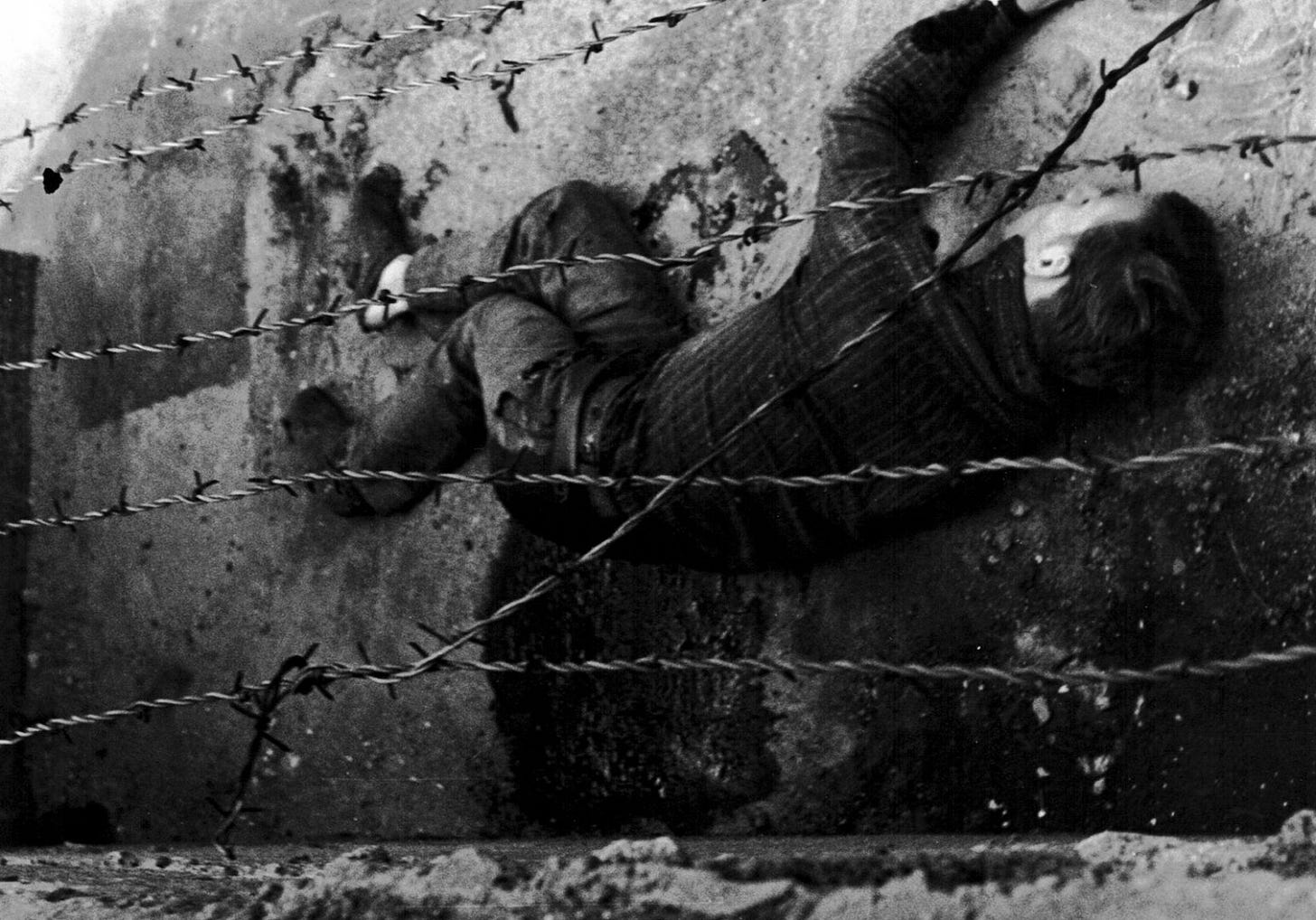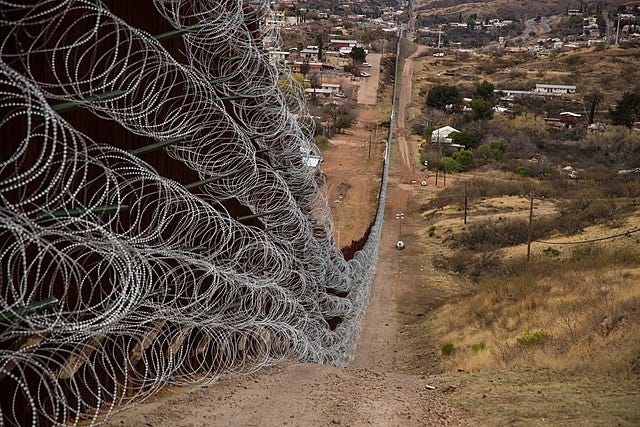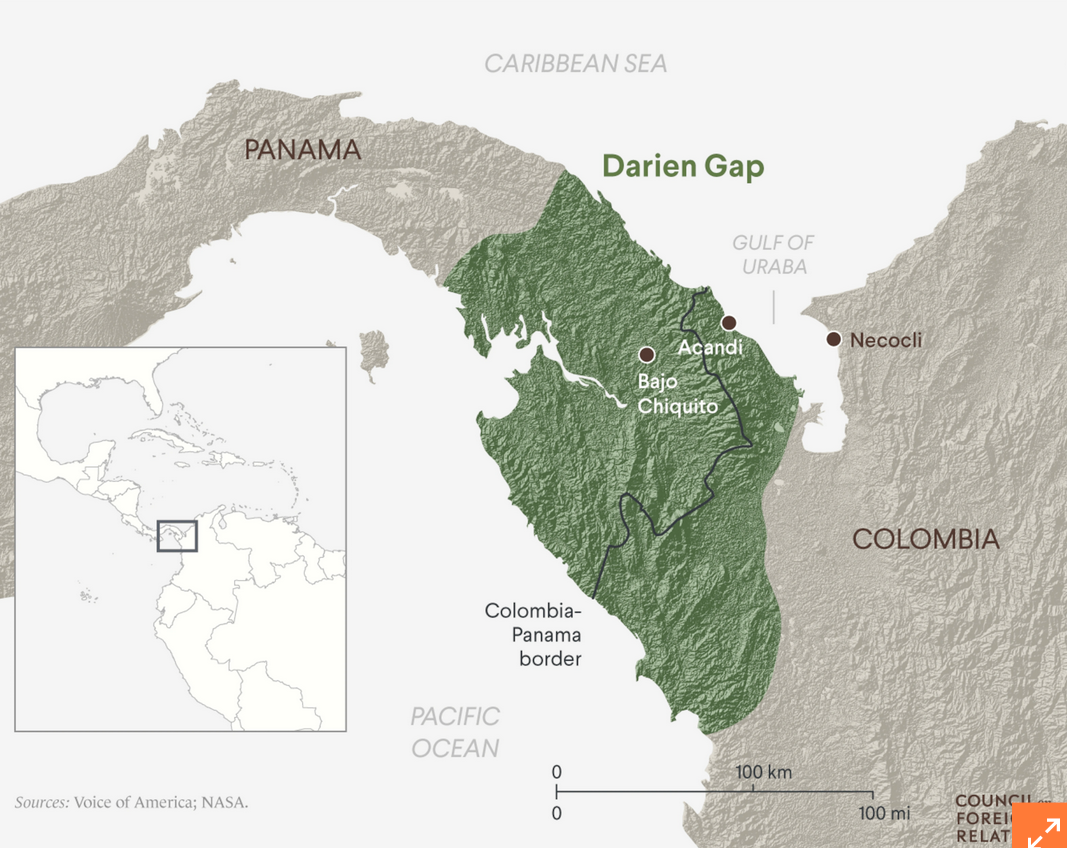A Tidal Wave of Migrants Stands at Our Southern Border. We greet them with razor wire.
We didn't feel the same when Peter Fechter died at the Berlin War, did we?
On 17 August 1962, an 18-year-old bricklayer named Peter Fechter and a friend of his decided to try to escape from East Germany to the freedom of West Berlin. They hid in a carpenter’s shed, observed the movements of the guards, and, at an opportune moment jumped into the Death Zone between the original Berlin wall and a parallel wall under construction and ran for the 6’6” fence on the west side. It was topped with barbed wire, but Fechter and his friend took the risk. Fechter’s friend made it over, but guards saw the two and shot Fechter in the pelvis. He collapsed back into the Death Zone and screamed in agony. No one on either side was allowed to help. Some people threw bandages, but Fechter couldn’t reach them. After an hour of unspeakable suffering, Peter Fechter bled to death, alone.
The entire world was outraged by the Berlin Wall. It separated families and denied people the liberty of being where they wanted to be. It caged them into the eternal hell of Stazi surveillance, of police interrogations, of Russian control, of poverty, and of the specter of living and dying in East Berlin’s gray world of depression and despair. Western TV coverage intermittently showed another one: as desperate man or woman trying to run fast enough and leap high enough to get out. People wrung their hands and raged at Russia.
More than two dozen people died trying to cross the Berlin Wall in the 28 years its stood. Last year alone, 686 people died at America’s southern border with Mexico.
All along the border, there are coils and coils of it—concertina wire—razor wire. To try to climb it is to invite grotesque injury or death. It is especially odious that the State of Texas mined the waters of the Rio Grande with this weapon, which should be as illegal as white phosphorus, and that was the brainchild of Greg Abbott, the state’s governor. Abbott is squared off against the federal government and the Supreme Court, which ordered him to surrender the border back to the Border Patrol. But he took it back over, and that’s when Sancha Cerros, 33, her daughter Yorlei Rubi, 10, and son Jonathan Agustín Briones de la Sancha, 8 died. Texas soldiers prevented the Border Patrol from approaching the border and preventing them from drowning.
The Southern Border is, in fact, in deep trouble. Democrats blame Republicans—and Republicans blame Democrats. But the problems are deeper than that.
A few months ago we published this post, which details the causes in Central and South America that we predicted would result in an unprecedented wave of migrants pressing upon our southern border. Then Biden put into effect his plan for stemming the tide of illegal immigration with new, tougher rules for applicants. In the ensuing confusion, the border went still and silent, and there was an almost instantaneous declaration of “mission accomplished”—an act of hubris that invariably angers the gods.
But the causes have not changed in the months since, and now the wave predicted by the governmental instability, poverty, gang violence, disease, long-term unemployment and racial inequity in the states to our south has arrived.
In the six months ending June 30th, the Border Patrol made 1.3 million arrests.
A desperate and viciously inhumane “solution” by Texas involved coils of razor wire in the Rio Grande. They were removed by court order. Several towns in the Southwest have declared a state of emergency. With migrants dumped by the busloads, New York City social services reeling.
This won’t stop.
We republish this post to provide a backgrounder for PolitiSage’s new subscribers—and to remind those with us for a while that the causes of these problems are neither Democrat nor Republican policies but deep issues of starvation, racism, and social terrorism that are locally generated—yet also heavily influenced by worldwide economic disparities, climate change, war (largely always over riches), and gender and color apartheid.
And as we said before: They are coming. What we have to tell you now is: They are here.
It is not, as popularly believed, that Democratic policies are encouraging wave upon wave of migrants to storm the U.S. southern border. It is our all-embracing self-centeredness that makes us believe that whatever goes right—or wrong—must always be a reflection of us. Often it is the case, as has been seen with all major cultures since antiquity, that a great power’s influence runs so deep and broad that it affects almost everything. That is not true in this case. What is happening with migration now—and will happen this year— is largely beyond what Americans do, no matter how we may want to explain away the tragedy or spin fault.
Far to the south of the 60,000 who have languished at the U.S.-Mexican border for months, awaiting the end of the COVID-era Title 42, there are millions of others from Central and South America and the Caribbean who will be on the move this year. Many will head north to the United States on the hope they can escape the life-threatening disintegration of their native countries—which have been subject to three devastating crises.
Crisis #1: The COVID-19 Pandemic
The rampage of COVID-19 through Central and South America was disastrous. Brazil—at sufferance of Bolsonaro’s far-right pandemic denial and anti-vaccine hysteria—had the second-worst infection numbers and death rate in the world. When the pandemic struck Brazil hard, there were hundreds of thousands of migrants from Central America already there, or on their way. There were also ever-growing numbers of Caribbean refugees, mainly Haitians besieged by poverty, a deadly outbreak of cholera, rampant homicide, and terrifying open warfare between criminal gangs. Both groups found a Brazil wracked by disease and ecological disaster. There were no jobs for migrants. And matters were about to get much, much worse.
Crisis #2: The Pandemic Economic Collapse
As in Brazil, there was initial pandemic denial in Mexico and Colombia. Colombia’s president, Iván Duque Márquez, refused to do anything until there were massive pot protests all over the country and people started fleeing the cities for the countryside. In Mexico, President Andrés Manuel López Obrador walked unmasked among frightened peasants, telling them that Jesus wouldn’t allow the pandemic to come to Mexico, so they could all just relax. Want a hug? He refused to cancel a 77,000-fan folk festival in Mexico City—arguably the mother of all super spreader events—even though he knew cases were already proliferating. The press were barred from speaking to hospital staff. Later López Obrador was seen, unmasked, chatting with El Chapo’s 90-something mother through the passenger window of her Rolls Royce.
In both Mexico and Colombia, cases skyrocketed, overwhelming unprepared hospitals and already weak and unstable social welfare systems. Both countries masked and distanced too late, and eventually businesses closed, supply chains broke at their weakest links, and the tourist trade collapsed.
The New York Times observed that the great pandemic recession
hit Latin America harder than almost anywhere else in the world, plunging millions into hunger, destitution and despair. A generation of progress against extreme poverty was wiped out. Unemployment hit a two-decade high. Russia’s invasion of Ukraine choked off a key pipeline for grain and fertilizer, triggering a spike in food prices.
As bad as they were, things were about to get much, much worse.
Crisis #3: Rampant, Widespread Violence
Some countries in Latin America, particularly Mexico and Colombia, have been besieged by drug trafficking and its violence for decades. Colombia has fared better in recent years, but the cartel violence in Mexico never waned. Before the pandemic, some nations—Nicaragua, Guatemala, Honduras, and El Salvador—had significantly recovered from the political wars, some lasting decades, that had plagued them in the 20th century.
But with COVID came new instability. With governments preoccupied with the pandemic and whole populations descending into desperate poverty, drug-related and cartel violence reemerged with lethal fury. Ecuador, with what the International Crisis Group calls its “proximity to major cocaine producers, dollarised economy and corruptible state institutions” is suffering open warfare between drug cartels—and attempts by some cartels to overthrow the government. Costa Rica edges toward civil war. Everywhere in Central America violence has surged from a recent deepening of cartel power and the birth of criminal gangs that prey on the poor.
A Perfect Storm for Displacement
The combination of these three crises left the poor of Latin America in the grip of the most sobering of truths: You will get out, or you will die. Dan Restrepo, Barack Obama’s principal adviser on Latin America, told the New York Times:
“You couldn’t come up with a worse set of facts to leave tens of millions of people with no choice but to move. It’s inevitable that you’d have massive displacement, it really is a perfect storm.”
For several years, the only thing that’s held back a flood of migrants at the southern border has been Title 42, a protocol put in place by the Trump administration to stonewall the millions who are effectively displaced under life-threatening circumstances. Since March 2020, the Border Patrol has invoked Title 42 a staggering 2.7 million times to prevent migrants from entering the United States.
But on May 11th, by court order, Title 42 lapsed, and fake news, deliberate and merely misinformed, raged over the Internet. There have been more than 96 million views of #titulo42 posts on TikTok. One read: “May 11: You cannot be deported. Title 42 has come to an end.”
Already hundreds of thousands, if not millions, are on the move. The U.N. expects more than 400,000 people from South America to attempt the trek through the Darién Gap, the deadly 70-mile stretch of mud-floored jungle that connects Central and South America, this year alone. The hordes will be almost 40 times the size of those that tried it between 2010 through 2020. Last year 61% of those crossing the Darién Gap were Haitian.
North of the Darién Gap, migrants from South America will be joined by others fleeing poverty and violence in Central America. They will try to move into Mexico, and from there to the United States. When they get to the border, they may be in for a big surprise—and heart-rending disappointment.
Post-Title 42 at the Border: Entry into the U.S. Becomes Harder
If migrants thought the end of Title 42 would mean easier access into the United States, they were wrong. Title 42 caused immigration to plunge—but violations carried no legal consequences.
On the positive side, the new Biden Plan protocols support the Trump-threatened DACA people and continue and expand Temporary Protected Status for at-risk migrants from El Salvador, Honduras, Nicaragua, Somalia, Sudan, Syria, Myanmar, Venezuela and Yemen—and earthquake-ravaged Haiti and Nepal. Biden’s plan continues and expands the HB-1 visa program for highly-skilled workers and extends the policy of allowing so-called “chain immigration,” under which naturalized U.S. citizens can sponsor family members living abroad.
Also on the positive side, the Biden Plan gives far more support to the border states incessantly hamstrung by migration problems other U.S. states never suffer. Hence, the bussing of migrants to the north by Texas and Florida, which, though completely odious, inhumane, dangerous, and asinine, was a wake-up call for places like New York City, which struggled to handle an influx that was a pittance when compared with the deluge of migrants the border states endure year after year. And Biden shored up the Border Patrol with U.S. Army troops for faster processing.
However, Biden’s plan is, in important respects, far more draconian than previous immigration policy sets:
Migrants who come into the country illegally face immediate expulsion and will be banned from seeking asylum for five years.
Before entering the United States, migrants must have attempted to gain asylum in at least one other country while on their journeys north.
Migrants must apply for asylum along legal pathways and are encouraged, if not required, to file petitions one year before planned entry.
Migrants must pass a “fear interview” to determine if they really do—or authorities think they really do—face a threat to life in the countries they fled.
Migrants may be subjected to facial recognition to identify them, but many migrants are dark-skinned and most facial recognition software functions poorly if at all in identifying dark-skinned people. FR results in even greater delays than migrants already face within the U.S. court system’s process, which normally takes at least a year.
The Long Road Ahead
Just minutes before Biden’s new immigration plan went into effect, the ACLU filed a lawsuit against it, claiming it “dramatically curtails the availability of asylum in the United States” and resembles Trump-era policies that were struck down in court. The Guardian reports that “Kennji Kizuka, the director of asylum policy with International Rescue Committee, described the administration’s policy as illegal and inhumane.” Said Kizuka:
“President Biden during the campaign made a lot of really welcoming pledges to roll back some of the most restrictive, most inhumane Trump administration policies. Unfortunately, of late, the administration has chosen to replace the inhumane and chaos-creating Title 42 policy with the highly restrictive asylum ban that violates both US and international law.”
But no president will tackle this problem. A comprehensive immigration plan can only be drafted and effected by Congress, which is presently thoroughly gridlocked. Year after year, decade after decade, the story is always the same: Congress does nothing.
Meanwhile, the Border Patrol this morning said it thought the migrant bottleneck would clear soon and that the influx of migrants would probably peak in the next few days.
This only means that authorities are not looking south into Central and South America and are not perceiving the wave that is coming. It is an act of willing blindness that drags vapid optimism down to the level of deep delusion.
Dan Restrepo is right. The pandemic—and the recession and violence that followed in its wake—created a perfect storm for the displacement of tens of millions of people.
Migration Has Its Roots in Racism and Poverty and Oppression
But there’s one more problem nobody talks about: staggering wealth income worldwide. People run because they are desperate. The greed and corruption and violence in poor countries makes people run—but worldwide, the game is just rigged. Rich nations abuse the labor in poor countries, which are drowning in debt. There’s no money for food and medicine. And racism continuously makes non-whites vulnerable to crushing poverty.
The devastating truth is that Ukrainian refugees, being white, are finding communities worldwide that will take them. The devastating truth is that the nation that has more of its citizens as illegal aliens in the United States is CANADA, NOT MEXICO. The United States didn’t take Jews during World War II, cancelling some of their visas as they were boarding ships. Those people died. And the racists in the border states and the federal government don’t want these people because they’re brown.
Is the flood of migrants out of control now? Yes. 9,500 were arrested in Texas just last week. And the border states, which are expected to take care of the problem, are angry for good reason. That doesn’t mean it’s OK to fly a guy in flip flops and no coat to Chicago in the dead of winter. What it does mean is that the border is a national problem, a problem with an incredibly corrupt Mexican government, and a problem of racist attitudes that infect everyone on both sides of the river with an antagonistic attitude that is hard to dispel.
AND this is a worldwide problem having to do with poverty, violence, corruption, a lack of jobs, and fear of extra-judicial bullying from gangs and religions. More than a million Muslims try to get out of the Middle East every year—to Europe and the Western Hemisphere. More than 44 million people in Sub-Saharan Africa are displaced.
The Only Thing That Will Work Is World Cooperation at the Point of Need
And rich countries—accustomed to blaming the victim—don’t want to help. They want to tell the poor to help themselves when they have nothing.
That’s not going to work. We have to get to work.





